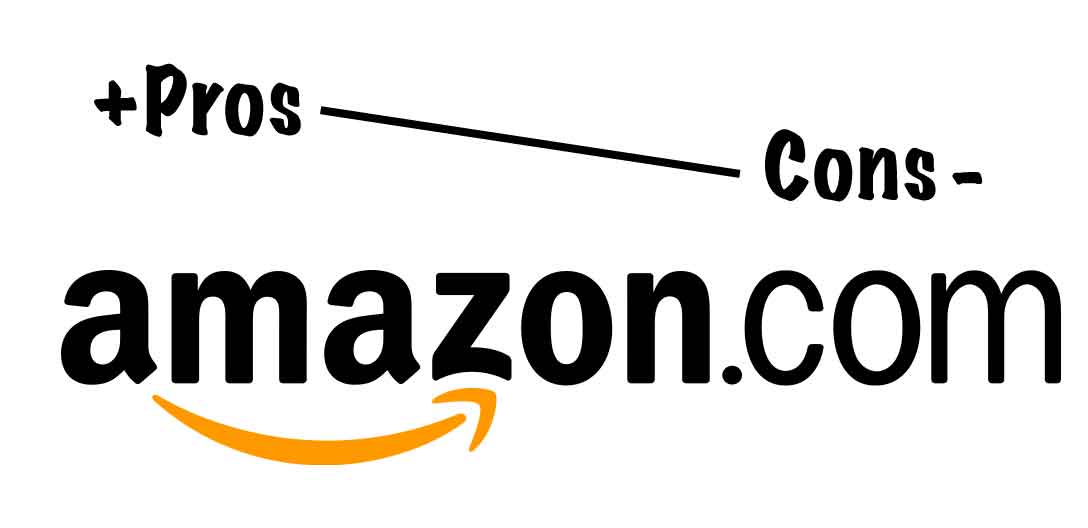Pros and Cons of Owning an Amazon Business
Over 200 million people visit Amazon.com each month. Amazon’s web traffic is unique in that most of the people on that ecommerce are there with the intention of purchasing. Amazon has over 100 million Prime members, meaning they purchase a high percentage of the things they buy on a regular basis from Amazon.
For anyone who’s connected with the world of ecommerce, you’ve learned one way or another about Amazon’s rise to dominance in online shopping, especially in the United States. As of 2018, Amazon had captured almost half of the ecommerce market in the United States, surpassing $250 billion in annual sales.
My Own Amazon Seller Story
When I first started selling products in 1999, I was using mostly eBay (which is now a very distant second to Amazon) and selling through the revolutionary auction style interface they presented to the world. Soon after I started selling on eBay, I opened my first ecommerce store and learned how to drive traffic to the products there (mostly ones that I drop-shipped from suppliers) using Google. This was prior to the existence of social media, so I relied mostly on writing unique product descriptions, optimizing titles, image names, etc., and doing link building. Later, my strategy evolved past old school SEO stuff to also use the various social media platforms that emerged, Facebook, Twitter, Pinterest, Instagram.
Sometime around 2010, I started getting regular solicitations from Amazon reps, asking me to start selling my products on their up and coming ecommerce platform as a 3rd party seller. Looking at their commission structure, and knowing that as a middleman drop-shipper, I couldn’t afford the Amazon fees and still make a profit (also, I’ll admit, lacking some creativity), I passed on several of their invitations to open a store on Amazon.
However, in 2015, I decided to finally take the plunge when I decided to take a small vinyl decor business, open an Amazon seller account, and put some of our products in the new Handmade category. I was surprised to see that we started getting orders almost immediately. With Amazon leading the charge, my wife and I were able to build the business into one that sold nearly $700,000 on Amazon in 2018, with much smaller amounts (very small fractions that amount) sold on my website, Etsy, and eBay.
To consistently grow the business over those few years, we mostly spent our time consistently adding new designs to our catalog. When someone ordered one our design, we’d make the product, ship it, and collect our profit. It was great.
Until that point, my Amazon experience was a great run to say the least. This past year, however, has been much different.
In June of 2019, Amazon flipped a switch on our main product category and essentially cut our sales in half. That’s not a great thing to ever experience, but it hurts much worse when you’re employing people who expect to have work to do. We’re still making efforts to overcome that sudden, crippling drop in sales. We learned a huge lesson: Amazon has the power to give, but it also has the power to take away just as quickly.
With that background, I’m going to explain to you what I’ve experienced as the pros and cons of owning and operating an Amazon business.
For some more context, I’ve also done other varieties of Amazon business, including doing private label product launches, retail arbitrage, and consulting for other business owners. At this point, five years after getting started with Amazon, I have enough experience to have witnessed most of the good and the bad that comes along with being an Amazon seller.
Pros of Owning an Amazon Business
As with my experience, there are lots of pros associated with owning a business that sells completely or mostly on Amazon. Here are some of the positives I’ve seen.
Access to Lots of Customers
Amazon has such a large number of users that you can sell almost anything on their platform. I have been surprised at the things that people are interested in purchasing. Some of our vinyl designs were so random and not very well thought out, including obscure quotes and other things, but people bought them.
Having access to millions of customers gives you a much higher chance that you can find a sweet spot on Amazon than with pretty much any other ecommerce venue.
Sales Start Coming in Quickly
Whenever I’ve started a new drop-shipping store that relied on traffic from Google, I’ve seen it take at least several weeks if not months to start getting enough legitimate traffic that I got orders. With Amazon, I learned that if you optimize your listing well and have a solid offer, you can start getting sales pretty much from day one.
Amazon gives newly listed products a “honeymoon” period (usually about 10-30 page sessions) to try them out. Often this will translate into quick sales that can beget more quick sales for your product if it converts well enough.
Much of the Marketing For Your Product Is Done For You
With other types of ecommerce businesses, selling off of Amazon, you have to spend a lot of time building your own traffic streams. With Amazon, those traffic streams are already there. Your responsibility is simply to harness that traffic for your benefit.
Lots of Selling Tools and Training Available
Because of how big Amazon is, there are lots of tools that have been created to help you understand where there are voids in the Amazon ecosystem that you can fill with new products. Some of the tools I use include the following:
- Merchant Words: keyword research
- Helium 10: several different tools including product rank tracking, competitor research, keyword research, product niche finders
- Jungle Scout: similar to Helium 10, but the tools are slightly different
Lots of Support From Communities
Again, because there are so many Amazon sellers, there are lots of opportunities to interact with other sellers and trade suggestions, get help, and otherwise become part of a community of like-minded small business owners.
Cons of Owning an Amazon Business
With the good things about Amazon, there are also lots of negative aspects of building a business focused there. Here are the major ones I know of.
It’s Not Easy, Takes Persistence and Iteration
Many of the Amazon training programs will tell you that it’s easy, that anyone can do it.
That’s not true. Just because there are lots of customers on Amazon willing to buy a range of random things doesn’t mean you will succeed without being persistent, observing what’s working and what’s not, and making changes whenever and wherever necessary. This principle goes for doing everything from retail arbitrage (which involves buying underpriced or liquidated products locally and sending them into Amazon for them to sell and fulfill) to private label, in which you create your own branded products and sell them on Amazon.
Amazon’s Platform Is Unpredictable
As with my experience running a thriving vinyl decor business that suddenly dropped in sales based on an algorithm change, it’s impossible to predict what Amazon is doing to do. Your business is never secure on Amazon. You could be rolling in the dough one day and then see your sales drop dramatically based on a random internal decision made in an Amazon strategy meeting you didn’t even know was taking place.
Also, speaking of Amazon’s formula, they automate a lot of the policing of their marketplace. That means that there are very often products and seller accounts that are terminated, suspended, or otherwise thrown out like babies with the bathwater. It’s almost impossible to anticipate when that might happen. The Amazon seller forums are full of stories of people who have decided to quit selling on Amazon because of what they believe is mistreatment by the ecommerce giant.
Your Customers Are Actually Amazon’s Customers
In the past, with all of my businesses, I’ve considered them my customers, people that I had a relationship with, that I could email when appropriate, call when necessary, and otherwise treat like a part of my community.
That relationship doesn’t exist on Amazon. They are careful to ensure that you know that it’s against their policy for you to use their phone number. As much as possible, they abstract customer information so as to avoid tempting you to even think about communicating with people who they consider to be their customers, and who have purchased your product only through the paradigm of your being a hidden, nearly silent guest on Amazon.
There are ways of overcoming this negative about Amazon selling, but you have to be creative to do so while remaining within Amazon’s terms of service.
Amazon Has Created a Culture Where Customer’s Cheat
Amazon’s commitment to the customer always being in the right has created an environment where many of the Amazon users know that they can get away with abusing sellers. All they have to do is complain, and they often get your product for free with no repercussions from Amazon.
Ask anyone who has been selling on Amazon for any significant amount of time, and you’ll likely be told several stories about customers abusing them without any recourse through Amazon, who considers its users much more important than 3rd party sellers.
Competition Is Fierce
Especially as Amazon has reached a critical mass in popularity, the competition has become fierce. The same tools I discussed above are used to find out which of your products are selling well (after you’ve put a lot of effort into making it that way), and competitors can rip off exactly what you’re selling. Often these are Chinese manufacturers, who undercut you in price and take away business.
In addition, there are getting to be so many sellers on Amazon that it really seems like there’s not much space available to share sales unless you have a product that is truly differentiated from the others, and that is not easy to imitate.
Competitors Can Often Sabotage Your Business
There are lots of instances I’ve read about, and some that I’ve experienced, where competitors find a way to sabotage your products, and where they can come after your entire seller account.
Fake negative reviews, falsely reporting supposed violations your account is doing to Amazon, and other tactics are used very commonly by competitors to try to tank your account and/or your products. Because Amazon is so big and doesn’t care about any particular seller, they’re not so much interested in justice and what’s correct. Instead, they often simply respond to a complaint by handing out a guilty verdict. The account owner is then left, often while his business is offline, to try to redeem himself on a timeline that is much different for Amazon than it is for any eager business owner.
Alternatives to Running An Amazon-Based Business
Although Amazon is a great place to sell and a great resource for selling products, it’s obviously best to diversify where your sales come from. It’s also a very good idea to put yourself in a situation where you “own” you customers, meaning that you have access to communicate with them through email addresses and phone numbers that you’ve collected outside of Amazon.
Ecommerce Website
Having your own website is always a good idea for ecommerce business owners. Your domain name and the website that resides there act as a solid home base for your customers. You have full control over the experience there, including sending out offers, collecting email addresses, keeping fees much lower than Amazon, and several other benefits.
Building an Audience
You can use any combination of several different social media platforms in addition to publishing content and optimizing for referrals from search engines to your website. Building a loyal following on Facebook, Instagram, Twitter, YouTube, Pinterest and in other places allows you to have access to an audience that you can consistently sell to without the blockading practices done by Amazon.
Other Selling Platforms
Besides your ecommerce web store and your social media presence, there are other ecommerce platforms, all of them much smaller than Amazon, but many of them safer in one way or another.
eBay
Selling on eBay used to be the big thing. It’s much smaller proportionally now, but still has a crowd that includes tens of millions of people ready to buy. Selling on eBay requires a different approach than selling on Amazon, but it can be a great source of revenue if you’re willing to learn how the system works.
Etsy
Etsy is for handmade items, and sometimes for other items that can pass as being like handmade. Etsy had nearly 40 million users in 2018. That’s much smaller than Amazon, but still worth pursuing. Etsy is much easier to use than Amazon in many ways, with a clear and straight forward product listing interface.
Walmart Marketplace
The Walmart.com marketplace is the third largest in the US, behind Amazon and eBay. Putting your products on Walmart.com is a little tricky, but once they’re on, you have access to millions of people, and the competition is nowhere near as fierce as it is on Amazon.
Conclusion
Hopefully this article has a given you a pretty good idea of what to expect when selling on Amazon. In all reality, there are still good opportunities to make a living through Amazon alone, but it’s best to not rely entirely on Amazon if possible.







